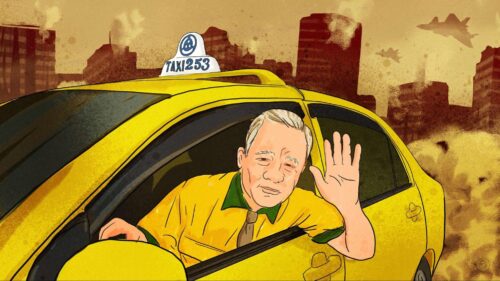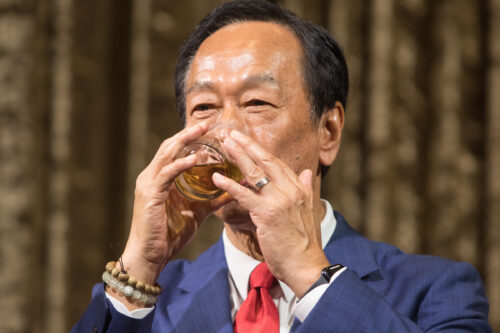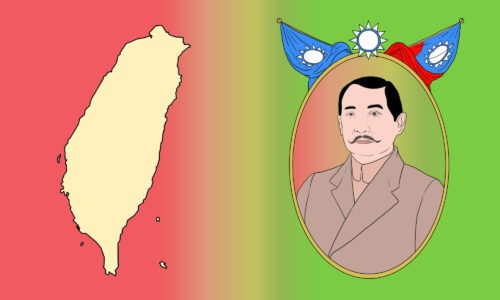In Taiwan, a law meant to empower the indigenous is put to the test
For the past half-century, Asia Cement has operated a quarry on indigenous land. But recently, the local community has questioned the company's right to do so. The issue will be up for vote in the near future.

At the entrance of Taroko Gorge National Park in Hualien stands a quarry, the second largest in Taiwan, scarring the mountain face of Xīnchéngshān 新城山. It is an eyesore for the millions of visitors to the park each year. But it also represents something else, which few know about: a watershed moment in Taiwanese indigenous history.
In June 2020, a judge used Taiwan’s Indigenous Basic Law (IBL) to say this quarry in Hualien could no longer operate, the first such application of the IBL. The decision was contested. Today, the local community — largely occupied by those from the Bsngan Tribe (玻士岸 bō shì àn) — is in the process of organizing a vote to decide whether the quarry, one of the oldest in Taiwan, operated by Asia Cement, should be allowed to continue.
The issue has split the community, even as activists have hailed the legal decision as a monumental win for indigenous rights.
The Bsngan Tribe, who belong to the Taroko people, one of Taiwan’s 16 recognized indigenous peoples, was formed in the 1930s, when the Japanese colonial administration consolidated six Taroko tribes defeated in the Truku War and forcibly relocated them to their current location. In the late 1950s, Asia Cement obtained the mining rights to the land from the ruling Chinese Nationalist Party (KMT), with land surveys beginning in the 1960s. According to Chén Yìfēng 陈毅峰, a professor at National Dong Hwa University who was commissioned by the government’s Indigenous Transitional and Historical Justice Committee to investigate the matter, the process in which Asia Cement received that land “had many flaws.”
Chen explains that at the time, indigenous land was held by the state, with local communities only receiving use rights from the KMT government. This was not fully understood by those in the local community, who saw the land as passed down to them from their ancestors. When Asia Cement and the government organized meetings with the community to explain the transfer process, most of the residents didn’t even know Chinese. Some believe Asia Cement coordinated with the local government and other intermediaries to forge documents and seals, releasing the land from the original owners. Although Asia Cement says it compensated all affected households, numerous individuals claim that they never received anything.
In 1973, Asia Cement gained final approval to begin boring into the mountainside. As a result, nearly 100 households lost their land, and dozens had to move due to their proximity to the quarry. The company promised to return the land after 20 years, but the quarry continued operating. To Chen, this whole process represents an “injustice.”
Tsai Yu Chi (蔡祐吉 Cài Yòují) from Asia Cement’s public relations office refutes these claims. He maintains that Chen’s investigation failed to demonstrate any illegal activities. He blames the residents’ feelings of injustice on the circumstances of the time, especially the status of indigenous people in Taiwanese society and the government. He emphasizes that any injustices perpetrated — including the use of improper seals, signatures, and the conveying of inaccurate information — is the fault of the government, and that residents should aim their demands for redress at the government, not Asia Cement.
The effects of the quarry on local residents have been substantial, says Buya Ici (白诚实 Bái Chéngshí), a local and vice chair of the Oppose Asia Cement, Return Our Traditional Land Self-Aid Association (反亚泥,还我传统土地自救会 fǎn yàní, huán wǒ chuántǒng tǔdì zìjiù huì). He recounts a time over the majority of the quarry’s existence in which its operations greatly affected the lives of residents. Daily explosions would violently shake the community, rocks would fall, destroying residents’ property, and dust would fill the village regularly. Asia Cement rarely communicated with locals. Employment was also a source of tension, with residents complaining that though the company promised at least one individual in each household would receive a job, this never materialized.
Today, most safety issues have been resolved. Explosions are small, and walls have been built to block potential rockslides. Flooding has been mitigated with the construction of ditches. Soil planted with local flora reduces the risk of soil erosion. Asia Cement has also begun providing benefits to the tribe, including subsidized daycare, utilities, home repairs, and local events. According to Tsai of Asia Cement, this all goes beyond what is legally required, and represents the company’s commitment to the community.
However, according to Lín Zhìmíng 林志明, a member of the Bsngan tribal council, employment continues to be a problem. Locals comprise 140 out of 1,000 total workers at the site, and most work for one of Asia Cement’s subcontractors, where benefits and wage are significantly lower. Lin complains that the opportunities for job training and career advancement are low, representing discrimination against locals.

In 2017, the Ministry of Economy approved a 20-year extension of the quarry’s mining rights without consulting the tribe. But in the preceding decade, the legal and political environment in Taiwan had changed.
In 2005, Taiwan’s legislature passed the Indigenous Basic Law, which contained language that would find echoes in the 2007 U.N. Declaration on the Rights of Indigenous Peoples. Within the IBL was Article 21, which guaranteed indigenous communities the right to informed consent over all economic activities within their reserved land.
Descended from groups of Austronesian people living on the island before large Han Chinese migrations began in the 17th century, Taiwan’s indigenous today constitute about 2.5% of the island’s population. Since the beginning of colonization, they have faced relocation, the destruction of traditional livelihoods, and marginalization in Taiwanese society.
In 2016, President Tsai Ing-wen (蔡英文 Cài Yīngwén) formally apologized to Taiwan’s indigenous for historical injustices, promising to champion the cause of indigenous rights. That same year, the Indigenous Peoples Council (原住民族委员会 yuán zhù mínzú wěiyuánhuì), Taiwan’s highest indigenous policy-making body, established the Consultation and Consent Mechanism (同意参与办法 tóngyì cānyù bànfǎ), which designated that enterprises had to first receive the approval of the majority of households in an indigenous community through a vote before beginning operations.
It was upon this legal basis that Xiè Mèngyǔ 谢孟羽, a lawyer at the Legal Aid Society who represents Bsngan residents dispossessed of their land, sued to stop the extension of Asia Cement’s mining rights. Various lawsuits initiated by residents over the previous decades failed to halt the quarry’s operations or win compensation. This time, Xie argued that because Asia Cement had not organized a process in accordance with the consent mechanism and Article 21 of the IBL, it was illegal.
Xie’s first lawsuit, filed in late 2017 after the extension’s approval, failed, but its appeal to the Taipei Supreme Administrative Court “surprisingly” succeeded, with a judge ruling in June 2020 that the extension of Asia Cement’s mining rights had to be canceled and could not continue until the company first attained the consent of the local community. According to Xie, this was a significant victory. Materially, the decision was a strengthening of indigenous rights, advancing indigenous law from visionary to concrete.

The decision shook Asia Cement. On March 29, the company sent a letter to the Bsngan tribal council, indicating that it would begin organizing information sessions that would initiate the informed consent process according to the “spirit” of Article 21 of the IBL.
As a result, the tribal council consulted with the community and brought forth 30 requests as a starting point in negotiations with Asia Cement, according to Lin. These included the establishment of a yearly dividend for the tribe, reparations, greater formal employment opportunities, and subsidies for events and utilities. While Asia Cement has partially answered the points, a robust dialogue has yet to be established.
Ici of the self-aid association believes that Asia Cement is not operating in good faith, maintaining that while a normal person would have a lengthy dialogue before obtaining consent over a matter, “capital behaves in unimaginable ways,” seeking only its own benefit. He sees Asia Cement as trying to “split the community,” hoping that this will weaken local opposition to the quarry. “You need harmony before you progress,” says Ici, meaning that the community must reach consensus internally and with Asia Cement before proceeding.
Lin, the member of the tribal council, doesn’t fully agree. He recognizes that a disjointed community favors the company, and that the benefits it has implemented are “a result of opposition.” He says that the task now is for the tribal council to take Asia Cement’s responses and present it to the community, allowing them to make an informed decision before voting to approve the quarry’s continued operation and to represent “the voice of the community.”
After a series of informational meetings and dialogue with Asia Cement, the tribal council will begin organizing the formal vote later this summer. The vote will include the heads of each household, and over half of total households must participate for it to be binding. The results will be certified as legally binding by the county government in conjunction with the Indigenous Council, with any promises made by Asia Cement deemed equal to a contractual obligation.
Xie, the lawyer, emphasizes that the consent mechanism developed by the indigenous council is deeply flawed, lacking clarity over when to initiate it, who can participate in voting, and whether industry must have a dialogue with the local community. It also uniformly imposes a rigid system on Taiwan’s diverse indigenous community, in which each tribe has a unique governing tradition. But perhaps most egregiously, it splits communities, damaging solidarity. “The results of voting are clear: division,” Xie says. He believes that it would be better to let indigenous tribes enact the informed consent mechanism according to their own traditional customs developed over generations.
Adralriw (Dù Zhāng Méi Zhuāng 杜张梅庄), director of the Office of Land Management at the Indigenous Peoples Council, understands the criticisms of the informed consent mechanism. He recognizes that numerous tribes have faced internal divisions as a result of instituting the mechanism. But he believes that “regulations need clarity” in order to be practical in “modern society.” He explains that the council only developed the mechanism after a thorough process of development that included consultation with communities and experts in various fields. Though communities using their own traditions is ideal, that is difficult to achieve in Taiwan, where there are 785 recognized indigenous tribes.
Adralriw emphasizes that regulations must be standardized in order to be practical to the entire society, including the ability to produce a final decision. In this era of democracy and diversity in Taiwan, that means voting. “If we don’t use voting, what other method is there?” he says.

The question of what will happen to the Xinchengshan quarry is still unclear. Xie, who represents the Bsngan community in court, fears the outcome of the legal cases’ final appeal. He worries that considering most people in Taiwan have a very shallow understanding of indigenous affairs, and that the legal system and education are only recently beginning to bring focus on indigenous issues, the judges overseeing the case will most likely not take a progressive approach, meaning the extension of the mining rights could still potentially move forward regardless of the vote in the tribe. Chen, the professor at Dong Hwa University, sees the “close relationship between capital and the state” as an impediment to the development of indigenous autonomy, something clearly affecting the Xinchengshan case.
The community itself lacks consensus. One resident surnamed Li claims that the problem lies with the government not sharing its tax revenue from the mine with the local community. “They’ve been collecting millions of dollars in taxes a year. Look around. Does it look like any of that has reached here?” he says.
Gujin Lan, another resident who has lived next to the quarry for over 20 years, laments that in her time safety hasn’t truly improved. She says will vote against the quarry regardless of whatever promises Asia Cement makes.
As for Lin, the tribal council member, acknowledging the centrality of the quarry to the community’s economy, he believes that the majority of the tribe supports the continuation of the quarry’s operation, but only after it has negotiated with the local community as equals. Asia Cement has made untold amounts of profit over the quarry’s over 40 years of operation, during which the tribe received no share. To him, it is time for the tribe, the true owners of the land, to get their due portion and right the injustices of the past.
In his eyes, this moment is part of a greater moment currently occurring in Taiwanese indigenous history, one in which tribes are building to a position of real autonomy and are recognized for their unique connection to the land. “We want to receive what we deserve,” he says.





